Saint John, U.S. Virgin Islands
| Nickname: Love City | |
|---|---|
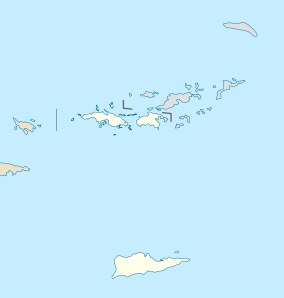 St. John | |
| Geography | |
| Location | Caribbean Sea |
| Coordinates | 18°20′N 64°44′W / 18.333°N 64.733°WCoordinates: 18°20′N 64°44′W / 18.333°N 64.733°W |
| Archipelago | Virgin Islands, Leeward Islands |
| Area | 19.61 sq mi (50.8 km2) |
| Administration | |
|
United States | |
| Insular area | United States Virgin Islands |
| District | Saint John |
| Largest settlement | Cruz Bay (pop. 2,706) |
| Demographics | |
| Population | 4,170 (2010) |
| Pop. density | 82.09 /km2 (212.61 /sq mi) |

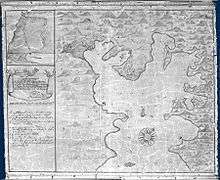

Saint John (Spanish: San Juan ; Dutch: Sint Hans; French: Saint-Jean ; Danish: Sankt Jan) is one of the Virgin Islands in the Caribbean Sea and a constituent district of the United States Virgin Islands (USVI), an unincorporated territory of the United States.
At 50 km2 the smallest of the three main US Virgin Islands, Saint John is located about four miles east of Saint Thomas, the location of the territory's capital, Charlotte Amalie. It is also four miles southwest of Tortola, part of the British Virgin Islands. Its largest settlement is Cruz Bay with a population of 2,700. St. John's nickname is Love City.
Since 1956, approximately 60% of the island is protected as Virgin Islands National Park, administered by the United States National Park Service. The economy is based on tourism.
Saint John is 50.8 km² (19.61 sq mi) in area with a population of 4,170 (2010 census).[1] As of the 2010 U.S. Census, the total population of the US Virgin Islands territory was 106,405,[2] comprising mostly persons of Afro-Caribbean descent.[1][2]
History
Saint John was first settled by the Taíno Indians who migrated north from coastal areas of present-day Colombia and Venezuela around AD 300. The Arawak inhabited the island until around the year AD 1300, when they were driven off by the more aggressive and warlike Carib. Extensive archaeological work started in 1996 at Cinnamon Bay. The artifacts from this dig are being studied and are expected to yield more detailed information on pre-Columbian civilization in the US Virgin Islands.
Explorer Christopher Columbus, traveling on behalf of the Spanish Crown, is credited with being the first European to see the Virgin Islands in 1493, during his second voyage to the New World. A Catholic, he named the group of numerous islands as Once Mil Virgenes (Eleven Thousand Virgins), in honor of the feast day of Saint Ursula and the 11,000 virgins who were martyred with her.
Colonization and settlement
The Danish West India and Guinea Company represented the first Europeans to settle the island in 1718. They are also credited with naming the island Saint John (Danish: Sankt Jan). The Danish crown took full control of this and nearby colonies in 1754, including those founded on the similarly named islands of Saint Thomas and Saint Croix.
Sugar cane plantations, such as the famous Annaberg Sugar Plantation, were established in great numbers on Saint John; the intense heat and fertile soil provided ideal growing conditions. The establishment of sugarcane plantations created a high demand for labor. The indigenous Carib and Arawak were initially used as slave labor but their population was quickly decimated by new infectious diseases.
The planters imported many slaves from Africa in an established slave trade dominated by Portugal in the early years, but which Britain also entered. In 1733 Saint John was the site of one of the first significant slave rebellions in the New World. Enslaved Akwamu from the Gold Coast rebelled and took control of the island for six months before being defeated by a combination of better armed forces.
The Danish defeated the enslaved Africans with help from French colonists of Martinique. Instead of submitting to captivity and slavery, more than a dozen men and women shot and killed themselves before the French forces reached them. It is estimated that by 1775, slaves outnumbered the Danish settlers on Saint John by a ratio of 5:1. Denmark finally abolished slavery in Saint John and its other islands on July 3, 1848.
Purchase
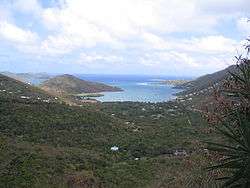
In 1917, during the First World War, the United States purchased the U.S. Virgin Islands for $25 million from the Danish government in order to establish a naval base. It was intended to prevent expansion of the German Empire into the Western Hemisphere. As part of the negotiations for this deal, the US agreed to recognize Denmark's claim to Greenland, which they had previously disputed.
During the 20th century, private investors acquired properties on the island, redeveloping some plantation houses as vacation resorts, such as Laurence Rockefeller's Caneel Bay Resort. The islands became popular and tourism and related service jobs developed as a major part of the economy.
Government
Since 1917, the U.S. Virgin Islands are an organized, unincorporated territory of the United States. Its residents are U.S. citizens, but they cannot vote in presidential elections.
Until 1970, governors of the territory were appointed by the US President. Since that year, residents of the island have elected a territorial governor and lieutenant governor, and fifteen senators to the legislature, representing all three islands. Seven are elected from the district of Saint Croix, seven from the district of Saint Thomas and Saint John, and one senator at-large (who must be a resident of Saint John) are elected for two-year terms to the unicameral Virgin Islands Legislature.
Residents of the Virgin Islands also elect a delegate to the US Congress, who has non-voting status in that body.
Saint John has no local government; however, the Governor appoints an administrator for the island. Having no official powers, this figure acts more as an adviser to the Governor and as a spokesperson for the Governor's policies.
The main political parties in the U.S. Virgin Islands are the Democratic Party of the Virgin Islands, the Independent Citizens Movement (ICM), and the Republican Party of the Virgin Islands. Additional candidates run as independents.
Voting
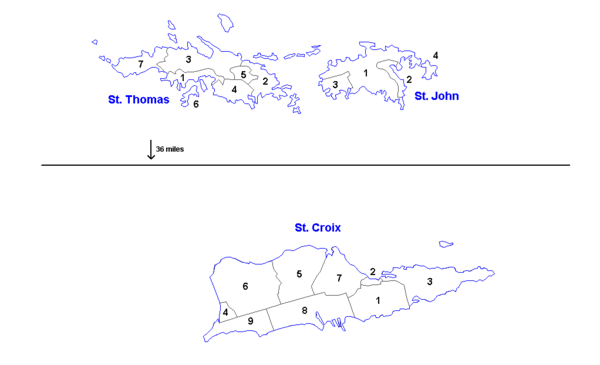
Saint John is divided into the following subdistricts (with population as per the 2010 U.S. Census):
Activists filed a lawsuit on September 20, 2011 in the federal US District Court of the Virgin Islands seeking the right to be represented in Congress and to vote for U.S. President. The case is Civil No. 3:11-cv-110, Charles v. U.S. Federal Elections Commission et al. The case alleges the 1917 Congress, with all-white members, denied the right to vote to island residents due to racial discrimination, as the island had a majority of people of color. The case was dismissed on August 20, 2012.[3]
Economy

The main export of Saint John used to be sugar cane, which was produced in great quantity using African and Indian slave labor. However, this industry declined after the abolition of slavery, as it was dependent on free labor to be profitable. In addition, in that period, it had to compete with sugar produced in other areas, including by the use of sugar beets in northern locations.
Tourism
The economy of St. John is almost entirely dependent on tourism. The island has hundreds of rental villas as well as the following hotels and resorts:
- Westin St. John Resort[4]
- Caneel Bay Resort[5]
- Grande Bay Resort[6]
- Gallows Point Resort[7]
- Concordia Eco-Resort[8]
- Cruz Bay Boutique Hotel[9]
- The Inn at Tamarind Court[10]
- St. John Inn[11]
- Estate Lindholm[12]
- Lavender Hill Suites[13]
Camping is available at Cinnamon Bay Resort & Campground inside Virgin Islands National Park.[14]
Numerous shops and restaurants serving both residents and tourists are located in Cruz Bay and Coral Bay.
St. John is a popular stop for day and term boat charters from the United States Virgin Islands, Puerto Rico, and the British Virgin Islands. Individual and group boat charters are widely available on St. John and island hopping is a favorite local and visitor activity. Popular day excursions include bar hopping or snorkeling at Christmas Cove, Jost Van Dyke, Buck Island National Wildlife Refuge, Tortola, Norman Island, Virgin Gorda, Water Island, Lovongo Cay, Cooper Island, and Peter Island. Mooring and anchoring locations are available in most bays around St. John for both day use and overnight stays.[15]
Virgin Islands National Park
In 1956, Laurance Rockefeller donated his extensive lands on the island to the United States' National Park Service, under the condition that the lands had to be protected from future development. The remaining portion, the Caneel Bay Resort, operates on a lease arrangement with the NPS, which owns the underlying land.
The boundaries of the Virgin Islands National Park include 75% of the island, but various in-holdings within the park boundary (e.g., Peter Bay) reduce the park lands to 60% of the island acreage.
Much of the island's waters, coral reefs, and shoreline have been protected by being included in the national park. This protection was expanded in 2001, when the Virgin Islands Coral Reef National Monument was created.
Transport
While St. John does not have an airport, the island is served by Cyril E. King Airport on nearby St. Thomas. There used to be a seaplane base[16][17] in the town of Cruz Bay. Antilles Airboats provided regular service until it was sold by Maureen O'Hara.[18] The Virgin Islands Seaplane Shuttle also used to offer services to that seaplane base using Grumman Mallard air boats prior to Hurricane Hugo.[19]
A ferry service runs hourly from Red Hook, St. Thomas, thrice daily from Charlotte Amalie, St. Thomas, and daily from Tortola; regular ferries also operate from Virgin Gorda, Jost Van Dyke and Anegada.[20]
Cars and cargo are transported to the island via barge. Two companies offer barge service between Red Hook, St. Thomas and Cruz Bay, St. John. The barges operate hourly during daylight hours. Virgin Islands law prohibits rental cars from using the car ferries.[21]
Car rental companies are located throughout Cruz Bay, most within easy walking distance of the ferry dock.
Taxis are widely available on St. John to provide transport to beaches, hotels, and vacation villas. Water taxi service is also available from Dolphin Water Taxi. [22]
VITRAN public bus service runs hourly on weekdays between Cruz Bay and Salt Pond Bay via Centerline Road.
Major port town
In the colonial era, Coral Bay was the hub of economic activity on the island. Its natural port offered protection to the sailing ships of the day. In addition, it was an easy sail by smaller boats, with minimal tacking, to the nearby British Virgin Islands. Until the late 20th century, the residents of Coral Bay and East End had easier and more frequent access to Tortola than did those of either Cruz Bay or St. Thomas.
Today, Cruz Bay is the port of entry to St. John. Cargo and car barges use The Theovald Eric Moorehead Dock and Terminal. Domestic ferries use the Loredon L Boynes Dock in central Cruz Bay. International ferries use the United States Customs and Immigration dock at the Victor William Sewer Marine Facility.[23]
Cruise ships visit Cruz Bay regularly during the winter, although they must anchor and deliver guests via tender.[24] St. John is also a popular day excursion for cruise ship passengers at port in St. Thomas or Tortola.
The waters surrounding the US Virgin Islands are patrolled by United States Coast Guard cutters out of Miami, Florida, and San Juan, Puerto Rico.
Education
St. Thomas-St. John School District operates schools for the island residents. Saint John has one public school, Julius E. Sprauve (JESS). Private and parochial schools include Gifft Hill School (formerly Pine Peace and Coral Bay), Saint John Christian Academy, Saint John Methodist School, and the Saint John Montessori School.
The only school that includes a high school is Gifft Hill, along with their programs in elementary and middle school. The only other middle school on the island is at 'JESS,' which also has an elementary program. The public high school for St. John students is Ivanna Eudora Kean High School located in Red Hook, St. Thomas.
Fiction
- In John Grisham's novel The Pelican Brief, the heroes escape to Saint John: specifically, a small cottage in Maho Bay, along the North Shore.
- Hawksnest Bay was the filming location for the Alien beach scene towards the ending of the movie Contact (1997).
- Grandma Raised the Roof by Ethel Walbridge McCully. Author's own story of building her dream home on St. John's VI and defending it from being acquired by the National Park Service, in the early 1950s.[25]
Gallery
 Gibney Beach on Hawksnest Bay, near home once owned by J. Robert Oppenheimer.
Gibney Beach on Hawksnest Bay, near home once owned by J. Robert Oppenheimer.
 Sunset at Caneel Bay
Sunset at Caneel Bay Wild donkeys at Caneel Bay
Wild donkeys at Caneel Bay Turtle Bay Beach at Caneel Bay
Turtle Bay Beach at Caneel Bay Sunset at Turtle Bay
Sunset at Turtle Bay Reef Bay and Virgin Islands National Park from Cocoloba Point.
Reef Bay and Virgin Islands National Park from Cocoloba Point.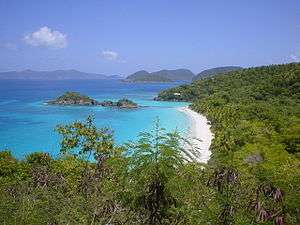 Trunk Bay Beach
Trunk Bay Beach Trunk Bay
Trunk Bay Virgin Islands National Park Building Saint John
Virgin Islands National Park Building Saint John Near Caneel Bay Saint John, U.S. Virgin Islands
Near Caneel Bay Saint John, U.S. Virgin Islands Beautiful Scenery Saint John, U.S. Virgin Islands
Beautiful Scenery Saint John, U.S. Virgin Islands Ruins
Ruins- Salomon Bay
- Salomon Bay from Honeymoon Beach
- Salmon Bay from Honeymoon Beach
See also
- Outline of the United States Virgin Islands
- Index of United States Virgin Islands-related articles
- Bibliography of the United States Virgin Islands
- Flanagan Island
- Great Thatch
- List of people from the United States Virgin Islands
- National Register of Historic Places listings on Saint John
- Norman Island
- Piracy in the British Virgin Islands
- Virgin Islands Coral Reef National Monument
References
- 1 2 "2010 Census U.S. Virgin Islands, United States Census Bureau". Retrieved October 4, 2012.
- 1 2 2010 Population Counts for the U.S. Virgin Islands, U.S. Census Bureau.
- ↑ Charles v. U.S. Federal Election Commission et al., Docket Alarm, 2012-2015
- ↑ "St. John Hotel | St. John Resort | The Westin St. John Resort". The Westin St. John Villas | Official Website | Best Rates, Guaranteed. Retrieved 2016-09-07.
- ↑ "Caneel Bay Resort | St John". www.caneelbay.com. Retrieved 2016-09-07.
- ↑ "Home | Grande Bay Resort in St. John USVI". Grande Bay Resort. Retrieved 2016-09-07.
- ↑ "Gallows Point Resort : Official Site : St John Hotels USVI". www.gallowspointresort.com. Retrieved 2016-09-07.
- ↑ "Concordia Eco-Resort - Welcome". www.concordiaeco-resort.com. Retrieved 2016-09-07.
- ↑ "Hotel Cruz Bay : Home". hotelcruzbay.com. Retrieved 2016-09-07.
- ↑ "The Inn At Tamarind Court – St. John – U.S. Virgin Islands". www.innattamarindcourt.com. Retrieved 2016-09-07.
- ↑ "St. John Inn". St. John Inn. Retrieved 2016-09-07.
- ↑ "Estate Lindholm - St John B&B Inn". Retrieved 2016-09-07.
- ↑ "St. John Villas and Vacation Rentals - Glorious Virgin Islands". www.lavenderhill.net. Retrieved 2016-09-07.
- ↑ "Cinnamon Bay Resort & Campground". Retrieved November 23, 2016.
- ↑ "Quick Mooring Information - Virgin Islands National Park". U.S. National Park Service. Retrieved 2016-09-07.
- ↑ http://airportsbase.org/Virgin_Islands/all/St_John_Island/Cruz_Bay_Seaplane_Base
- ↑ http://ourairports.com/airports/SJF/#lat=18.3315,lon=-64.79599999999999,zoom=14,type=Satellite,airport=SJF Cruz Bay Seaplane Base-OurAirports
- ↑ http://virginislandsdailynews.com/news/maureen-o-hara-left-mark-in-virgin-islands-1.1962940
- ↑ http://capnaux.blogspot.com/2012/11/hurricane-hugo-part-2.html
- ↑ http://www.vinow.com/travel/virgin-islands-ferry-schedules/
- ↑ "Government warns on car rentals". US Virgin Islands News. Retrieved 2016-09-07.
- ↑ User, Super. "Water Taxi in the Virgin Islands - Dolphin Water Taxi". www.dolphinshuttle.com. Retrieved 2016-09-07.
- ↑ "The United States Virgin Islands' Airports and Seaports". Virgin Islands Port Authority. Retrieved 2016-09-07.
- ↑ "Ship Schedule - Port Availability". www.wico-vi.com. Retrieved 2016-09-07.
- ↑ "ETHEL MCCULLY, SAVED VIRGIN ISLANDS HOME FROM CONDEMNATION". NYTimes.com. January 4, 1981. Retrieved November 4, 2015.
Ethel Walbridge McCully, the grandmother who went to Washington to ''raise a little hell'' on Capitol Hill in 1962, died Dec. 21 on St. John in the Virgin Islands in the home she successfully defended against condemnation by the National Park Service. She was 94 years old. Mrs. McCully was a secretary in New York City in 1947 when, on one of her frequent trips to the Caribbean, she first saw the island of St. John. She swam ashore with a basketful of belongings because the captain of her English cruise ship declined to dock at the then undeveloped island. Mrs. McCully, a small, outspoken woman, bought four acres, designed her dream house and spent 11 years struggling with suppliers, boat captains and workmen to build it. She described her tribulations in a book entitled Grandma Raised the Roof. Her home, called Island Fancy, was jeopardized in 1962 by a clause in a Congressional bill calling for the enlargement of the Virgin Islands National Park. The clause would have let the National Park Service acquire land on the island by condemnation. With other island homeowners, Mrs. McCully lobbied to get the provision struck from the bill. Some years ago, Mrs. McCully reluctantly sold the house to the Park Service with the proviso that she would have life tenancy.
- "St. John Tradewinds"—major Saint John newspaper, est. 1972
- Rankin, D.W. (2002). Geology of St. John, U.S. Virgin Islands. U.S. Geological Survey Professional Paper 1631. Washington, D.C.: U.S. Department of the Interior, U.S. Geological Survey.
- "36 Hours in St. John"—2006 New York Times article by Jon Rust
- "Why I Gave Up a $95,000 Job to Move to an Island and Scoop Ice Cream"—2015 Cosmopolitan article by Noelle Hancock
- Checklist: St. John, U.S. Virgin Islands - Stephanie Burt, Paste Magazine
- "House Hunting on ... St. John"—Marcelle S. Fischler, The New York Times
External links
| Wikimedia Commons has media related to Saint John, United States Virgin Islands. |
| Wikisource has the text of a 1911 Encyclopædia Britannica article about Saint John. |
| Wikivoyage has a travel guide for Saint John, United States Virgin Islands. |